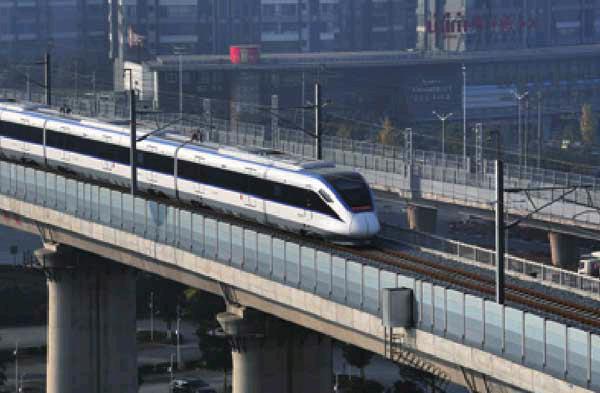Home,Sweet Home
2016-12-28
Giant panda Meihuan plays at the Research Base of Giant Panda Breeding in Chengdu, Sichuan Province, on December 6.
Meihuan and her sister Meilun were born in Atlanta in July 2013. Their parents, Lunlun and Yangyang, have been living in the United States since 1999.
According to the lease agreement between China and the United States, pandas that are born abroad should be returned to China by the age of four.
Income Goal
China will intensify policy support in the next five years to narrow the urban-rural income gap and double farmers 2010 average per-capita income by 2020, according to a newly released State Council document.
The government will increase investment in agricultural infrastructure construction and strengthen financial services in rural areas, it said.
More policies will be unveiled to support rural residents to explore entrepreneurship and innovation, and provide more training services to farmers on their agricultural skills.
Other measures include encouraging private investment in rural areas to broaden channels for farmers to increase their income and deepening the reform of rural collective property rights to inject vitality into rural areas.
The social safety net in rural areas will be improved, helping farmers to shake off poverty and live comfortably.
China spent 20.36 billion yuan($3.2 billion) in 2015 in developing modern agriculture, underscoring the nations efforts to deepen rural reform.
TCM White Paper
The Chinese Government published its first white paper on traditional Chinese medicine (TCM) on December 6, detailing policies and measures on TCM development and highlighting its unique value in a new era.
“TCM has created unique views on life, on fitness, on diseases and on the prevention and treatment of diseases during its long history of absorption and innovation,” said the white paper, titled Traditional Chinese Medicine in China, published by the State Council Information Office.
As ideas about fitness and medical models have changed and evolved, TCM has become more and more profound in its value, the document said.
“TCM has been comprehensively developed in China which is now able to offer health services covering the [whole] life cycle,” said Wang Guoqiang, Director of the State Administration of Traditional Chinese Medicine.
TCM and Western medicine have different strengths. They work together in China to protect people from diseases and improve public health. This has turned out to be a unique feature in the development of Chinas medical and health sector, according to Wang.
Hailing the establishment of a TCM service system covering both urban and rural areas in China, the white paper said, by 2015, the nation had 3,966 TCM hospitals, 42,528 TCM clinics and 452,000 TCM practitioners and assistant practitioners.
In addition to contributing to the prevention and treatment of common, endemic and difficult diseases, TCM has played an important role in the prevention and treatment of major epidemics such as SARS, HIV/AIDS and Hand, Foot and Mouth Disease, the white paper said.
With its relatively low costs, TCM delivers a comparatively high share of medical services in relation to the resources it receives. That share increased from 14.3 percent to 15.7 percent from 2009 to 2015, according to official statistics.
In 2015, out-patient expenses per visit and in-patient expenses per capita at public TCM hospitals were 11.5 percent and 24 percent lower than those at general public hospitals, respectively.
There were 910 million visits in 2015 to TCM medical and health service units across the country.
To date, 60,000 TCM and ethnic minority medicines have been approved, and 2,088 pharmaceutical enterprises have been licensed to manufacture Chinese patent medicines.
Community Service
A draft law was published on December 1, under which the government will provide more support for criminal community service programs and the protection of juvenile offenders rights. Public opinion on the draft, which was released by the Legislative Affairs Office of the State Council, is being solicited.
The law aims to regulate community service, help offenders return to society and prevent further crime.
Community service mainly applies to offenders given noncustodial sentences.
Local governments should help and educate people undertaking community service while correction agencies should provide training and help find employment, the draft said.
The supervision and management of juvenile offenders should be separated from that of adults, and authorities should tailor correction measures according to juvenile offenders age and mentality.
Details about correction measures applied to juvenile offenders will not be made public.
Offenders engaged in community service can participate in social insurance programs and apply for social and legal assistance, according to the draft.
Webcast Shutdown
Thousands of accounts have been shut down by Beijing-based live streaming websites for broadcasting illegal or improper content since a regulation went into effect on December 1, authorities said on December 6.
Reports of violent, obscene and vulgar content on live streaming websites abound. In November, the Cyberspace Administration of China published a regulation banning the use of live streams to undermine national security, destabilize society, disturb social order, infringe upon others rights and interests, and disseminate inappropriate content, including pornography.
According to the regulation, service providers are obliged to censor content before releasing it and are instructed to establish a system that will allow them to block improper live streams immediately.
So far, more than 4,500 accounts on Beijing-based websites have been closed, and over 3,100 illegal live streaming programs have been removed, according to Beijings cyberspace administration.
Officials with the administration said they will enhance regulatory efforts to “safeguard order in the Internet industry.”They also called on the public to join in the supervision.
Delicacy Feast
Cooks make dishes during the Eighth Fish Fair, an agritourism promotional event, in Digang Village of Huzhou, Zhejiang Province, on December 2.
Mourning Their Losses
A local resident mourns victims of the Nanjing Massacre in 1937 at a ceremony in Nanjing, Jiangsu Province, ahead of the National Memorial Day for Nanjing Massacre Victims, which fell on December 13.
More than 300,000 Chinese people were slaughtered by Japanese troops in the massacre.
Hearing Health
More than 20,000 impoverished Chinese children with severe hearing impairments have received artificial cochlea implants for free since 2009, according to Duan Yong, an official from the National Health and Family Planning Commission.
The government has allocated a total of 2.3 billion yuan ($335 million) for the program launched in 2009.
Duan said at a meeting organized by the World Health Organization on December 6 that China sets great store by peoples hearing health care.
He added that the health authority will strengthen its efforts in this regard, especially in the prevention of birth defects and newborn screening, as well as improving the capabilities of rural health institutions.
Heritage Protection
A total of 3.5 billion yuan ($510.39 million) has been spent on the protection of two world heritage sites in Sichuan Province over the past two decades, local authorities said.
The UNESCO World Heritage Committee inscribed Mount Emei Scenic Area and Leshan Giant Buddha Scenic Area on its World Heritage List in 1996. A celebration of the 20th anniversary of the inscription was held in the city of Leshan on December 6.
Over the past two decades, tourism in Leshan has grown significantly. Official statistics show some 40 million people visit the city annually, spending 50 billion yuan ($7.26 billion).
PMI Expansion
Chinas manufacturing activity expanded for the fourth month in November, providing further evidence that the Chinese economy was strengthening.
The manufacturing purchasing managers index (PMI) was 51.7, up from 51.2 in October, remaining above the 50-point boom-bust line for the fourth straight month, the National Bureau of Statistics (NBS) said on December 1.
The last time manufacturing had expanded at this pace was in July 2014; the last time the figure had exceeded 51.7 was in April 2012, when it reached 53.3.
NBS statistician Zhao Qinghe attributed the steady uptrend to improving domestic demand, booming manufacturing in consumer goods and hi-tech sectors, and better foreign trade figures.
The sub-index for production rose for a fourth month to 53.9, while that for new orders moved up for a second month to 53.2, both hitting their highest point this year.
The non-manufacturing activity also expanded at a faster pace in November, with the PMI rising to 54.7 from 54 in October.
On the Fast Track
A trial run on the Changsha-Zhuzhou-Xiangtan inter-city railway in Hunan Province on December 6.
Trains can run at 200 km per hour on the 95.5-km railway, which will become operational at the end of this year.
Biomass Energy
The National Energy Administration on December 5 issued a five-year biomass energy development plan, proposing to use the biomass energy equivalent of 58 million tons of coal by 2020.
The use of biomass energy will be commercialized and industrial- ized more in the five years, according to the document.
Biomass is defined as biological material—generally farm or forestry byproducts—that can be used directly to produce heat via combustion or indirectly after being converted into biofuels.
Although China produces the biomass energy equivalent of about 460 million tons of coal annually, mostly for biogas, biomass power generation and biomass heating, the vast majority is not harnessed properly as the right technology is not fully in place.
China is promoting non-fossil energy to power its economy in a cleaner, more sustainable fashion. The government aims to lift the proportion of non-fossil energy in the energy mix to 20 percent from the current level of around 11 percent by 2030.
Lighter Tax Burden
China will continue to improve its value-added tax (VAT) policies to ease companies tax burdens, according to an executive meeting of the State Council on December 1.
The VAT system was rolled out nationwide in May in place of business tax after successful pilots. By the end of October, companies have saved 96.5 billion yuan ($14 billion), according to official statistics.
All 26 economic sectors covered by the VAT program including finance, construction, real estate and livelihood services have seen their taxes reduced, said a State Council statement.
The government estimates that 500 billion yuan ($72.70 billion) will be saved this year.
Policymakers expect the tax breaks will help the development of the service sector and other new economic drivers and aid the nations economic transformation.
The government will keep a close eye on the program and make more efforts to reduce business burdens and stimulate market vitality, the statement said.
Steel Merger
Shanghai-based Baosteel Group and Wuhan Iron and Steel Corp. in central Chinas Hubei Province have merged to form the China Baowu Steel Group on December 1.
The combined steel output of the two groups is about 60 million tons, exceeding that of Hesteel, Chinas current top producer, and coming in second place worldwide after ArcelorMittal, according to 2015 data from the World Steel Association.
The new group is estimated to have 228,000 employees, general assets worth 730 billion yuan($106 billion) and an annual revenue of 330 billion yuan ($44.54 billion).
The merger is an important move to promote Chinas economic restructuring and improve Chinese steelmakers competitiveness in the international market, Baowu Chairperson Ma Guoqiang said.
The State-Owned Assets Supervision and Administration Commission of the State Council approved the merger in September.
China is the worlds largest producer and consumer of steel. Annual steel production is 1.2 billion tons. However, the country has been aiming to reduce its production capacity by 45 million tons this year.
Aviation Plan
The Australian and Chinese governments have agreed to open the aviation market between the two countries.
The new arrangement will remove all capacity restrictions between Australia and China for each countrys airlines, allowing Australian tourism businesses to take advantage of the largest and fastest growing consumer market in the world.
“We have also liberalized traffic rights and code-share arrangements, which are important for Australian airlines. This will enable Australian and Chinese airlines to service destinations between and beyond both countries, and will allow them to take full advantage of their cooperative arrangements with their commercial alliance partners,” said Australian Minister for Infrastructure and Transport Darren Chester on December 4.
Australian Minister for Trade, Tourism and Investment Steven Ciobo said there is unlimited potential for Australian tourism following the agreement.
“China is Australias fastest growing and highest spending international visitor market. More than 1 million Chinese tourists visited Australia in 2015-16 (up 22.3 percent from the previous year), and spent almost AU$9 billion ($6.7 billion),”he said.
The number of outbound Chinese travelers is predicted to double to over 200 million annually by 2020. “This agreement will help Australia snare a larger slice of that, creating more Australian jobs and economic growth,” Ciobo said.
Some Like It Hot!
A farmer dries chili in Xiaoliuwantou, a village in Guangzong County, Hebei Province, on December 5.
The output of chili in Guangzong is expected to reach 5 million kg this year, generating 60 million yuan ($8.7 million) for local farmers.
Row Your Boat
A visitor tries a rowing simulator during a virtual and augmented reality expo in Changchun, Jilin Province, on December 2.
More than 40 enterprises and universities participated in the event.
TV, Film Deals
Chinese and British cultural firms signed five cooperation deals in Shanghai on December 1.
The Unanico Group, an award-winning independent production company and animation studio based in London and Shanghai, signed a 40-millionpound ($51.01-million) agreement with China Lion Entertainment Production for co-production and distribution of animated feature films. The start of production for the first film will be announced in the first half of 2017.
Unanico also announced a three-year strategic partnership with Hunan Mango Entertainment for action films.
Cloth Cat Animation, based in Cardiff, and Chinese company Magic Mall announced collaboration on a 52-episode animation series based on Magic Malls successful character Luo Bao Bei. The series will be produced in Britain and distributed around the world.
Lion Television and Chinas Jiangsu Broadcasting Corp. also signed an agreement to co-produce Tales From Modern China, a program exploring ancient and modern Chinese civilizations from a global perspective.
Abertay University signed a partnership agreement with Beijingbased video game maker Perfect World to increase learning opportunities in computer games for Chinese graduates.
At the signing ceremony, Tong Gang, deputy head of the State Administration of Press, Publication, Radio, Film and Television, said China pays attention to the development of cultural industries and gives priority to Sino-British cooperation.
The two countries signed a deal to co-produce films in 2014 and so far this year, six such films have hit the screen, Tong said, adding that the two sides have huge cooperation potential in creative industries.
